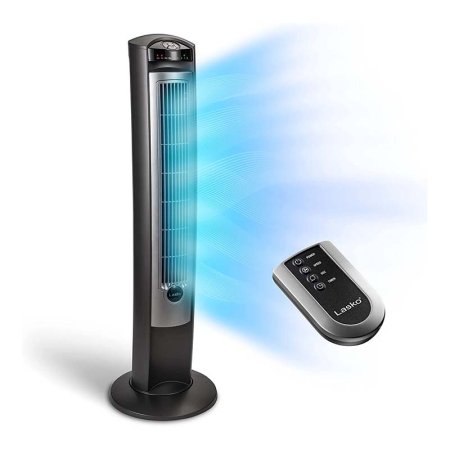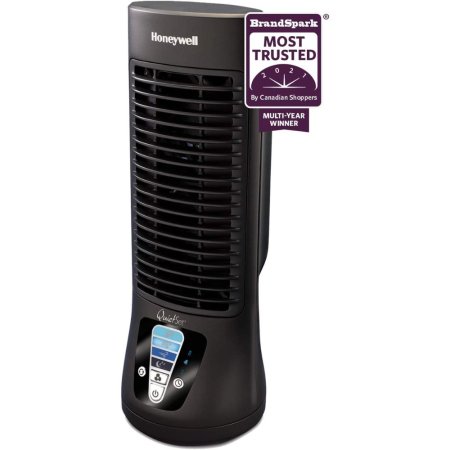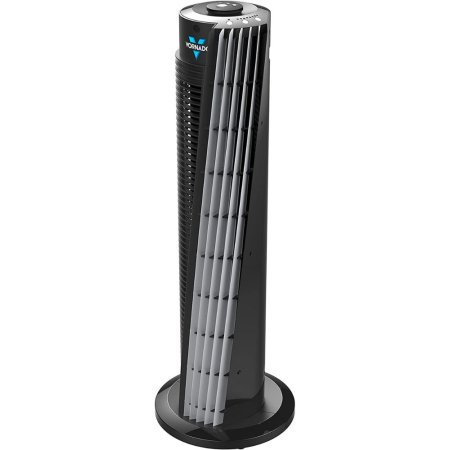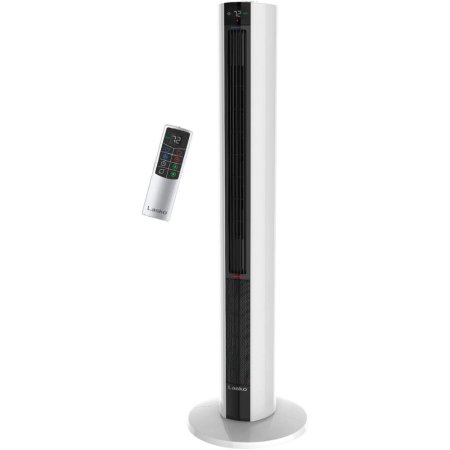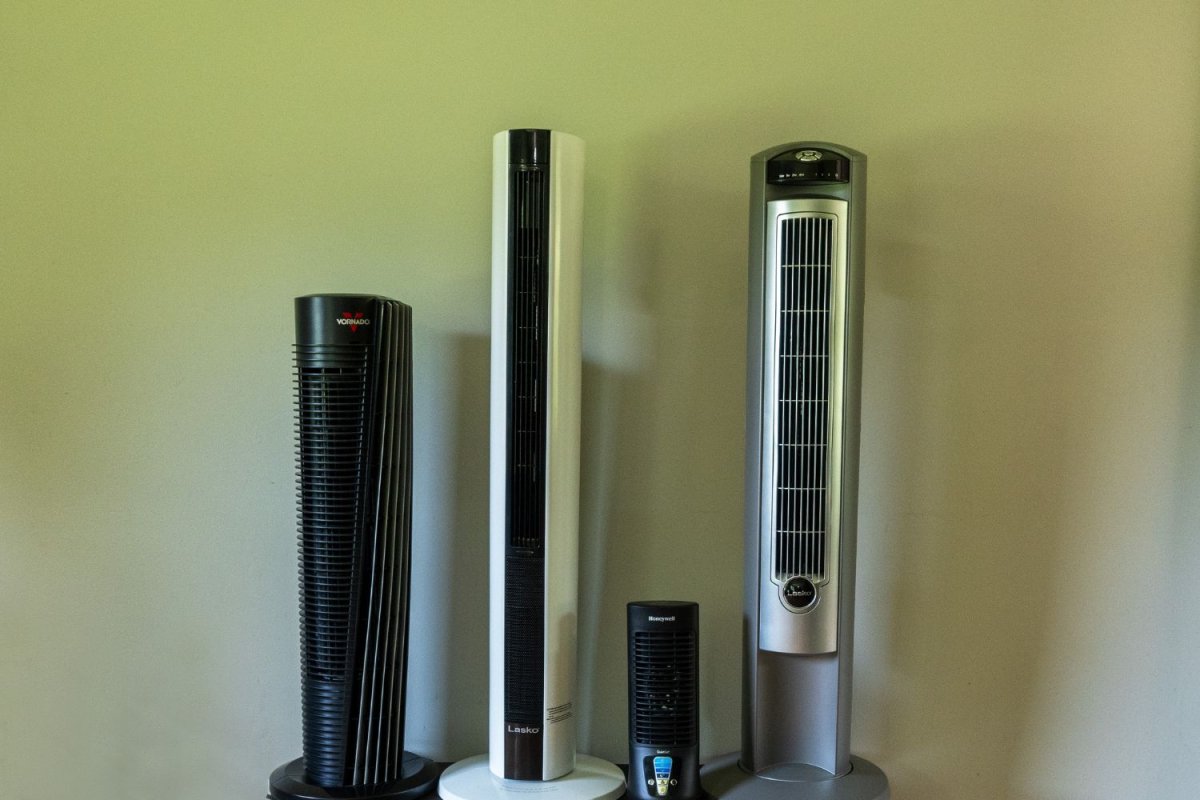
We may earn revenue from the products available on this page and participate in affiliate programs. Learn More ›
Of all the best fans that exist on the market—window, pedestal, box, and wall-mount varieties—tower fans often rise above the rest. Why? Their appeal lies in their combination of high efficiency, space-saving design, surprisingly quiet operation, heating and cooling, and smart features.
We have tested more than a dozen different types of fans over the years. Our favorite tower fan is the Lasko T42951 42-Inch Wind Curve Oscillating Tower Fan due to its straightforward functionality, modern design, and attractive price point. Keep reading to learn more about these fans, get tips on navigating the available options, and explore some of the best tower fans available.
- BEST OVERALL: Lasko T42951 42-Inch Wind Curve Oscillating Tower Fan
↓ Jump to Review - BEST BANG FOR THE BUCK: Honeywell QuietSet Mini Tower Table Fan
↓ Jump to Review - BEST AIR CIRCULATION: Vornado 154 32-Inch Tower Circulator
↓ Jump to Review - BEST HEATER AND FAN: Lasko FH500 1500W All-Season Tower Fan & Space Heater
↓ Jump to Review - BEST WITH IONIZER: Lasko T42950 Wind Curve Tower Fan With Ionizer
↓ Jump to Review - BEST BLADELESS: Shark TurboBlade Ultra-Quiet Bladeless Fan
↓ Jump to Review
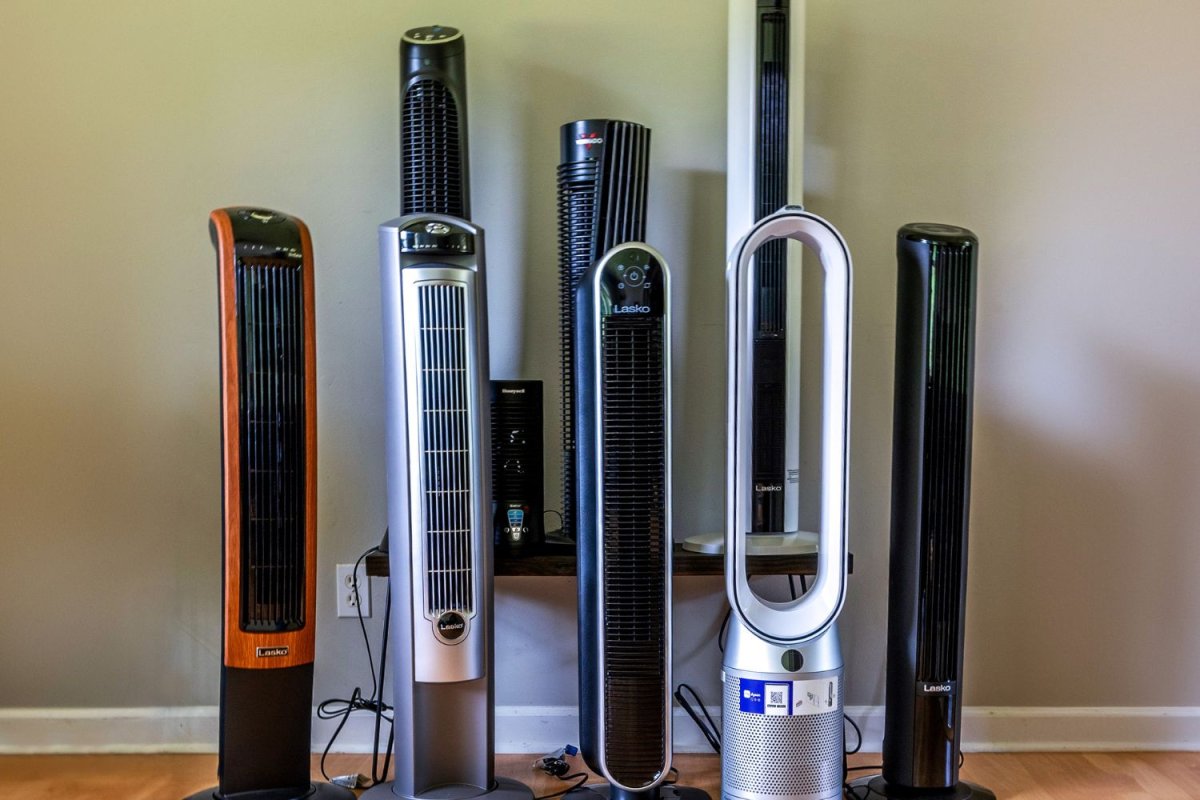
| Type | Highest cubic feet per minute (CFM) setting | Fan Speeds | |
| Lasko T42951 42-Inch Wind Curve Oscillating Tower Fan | Floor standing | 720 | 3 |
| Honeywell QuietSet Mini Tower Table Fan | Tabletop | Not provided | 4 |
| Vornado 154 32-Inch Tower Circulator | Floor standing | 385 | 4 |
| Lasko FH500 1500W All-Season Tower Fan & Space Heater | Floor standing | 350 | 4; 3 heat settings |
| Lasko T42950 Wind Curve Tower Fan With Ionizer | Floor standing | 262 | 3 |
| Shark TurboBlade Ultra-Quiet Bladeless Fan | Floor standing | 1,600 | 10 |
Our Top Picks
These top picks have been listed in a variety of categories to suit the unique needs of individual users. Read on to discover some of the best tower fans on the market today for cooling your home.
Best Overall
Lasko T42951 42-Inch Wind Curve Oscillating Tower Fan
What We Like
- Wide oscillation for even air distribution
- Night mode dims lights and fan speed
- 3 fan speed settings with remote
- Programmable auto-off timer
What We Don’t Like
- Not suited for larger rooms
Specs
- Type: Floor standing
- Highest cubic feet per minute (CFM) setting: 720
- Fan speeds: 3
Our Ratings: Ease of Use 5/5; Air Circulation 5/5; Noise 4.5/5; Portability 5/5; Value 5/5
After testing the Lasko T42951 42-inch Wind Curve oscillating tower fan, we can confidently share that it’s a worthwhile purchase for anyone needing a straightforward, reliable cooling solution for moderate-size rooms. We highly value basic functionality and ease of use; this fan checks all the boxes.
The tower fan’s design is sleek and unobtrusive, making it a natural addition to most room decors. It stands at 42 inches tall, allowing optimal air distribution at a level that feels more natural when seated or lying down. The intuitive user interface features simple button controls and a basic remote control that makes operation straightforward from across the room. Regarding performance, the Lasko T42951 excels in moderate-size spaces such as bedrooms or small living rooms. It offers a range of speeds and an oscillation feature that helps distribute cool air evenly. We particularly appreciate the quiet operation, which is quiet enough not to disturb while sleeping or working.
However, its effectiveness wanes in larger spaces. In our large open-plan living area, the fan struggles to provide the same level of cooling. This isn’t a deal-breaker but something to consider if you want to cool a larger area. The Lasko T42951 is a solid choice for anyone looking for a no-frills, effective fan for smaller spaces. Its ease of use, effective cooling, and quiet operation make it a standout option, rightly earning its place as our best overall tower fan.
Get the Lasko T42951 tower fan at Amazon, The Home Depot, or Walmart.
Best Bang For The Buck
Honeywell QuietSet Mini Tower Table Fan
What We Like
- Slim, compact design
- 4 fan speed settings and oscillation
- Auto shut-off timer
- Touch control panel
What We Don’t Like
- Suited for personal use only
Specs
- Type: Tabletop
- Highest CFM setting: Not provided
- Fan speeds: 4
Our Ratings: Ease of Use 5/5; Air Circulation 4/5; Noise 5/5; Portability 5/5; Value 5/5
The Honeywell QuietSet mini tower table fan is a refreshing addition to any desk setup. Firstly, the desk fan’s slim, compact design is a major plus. It fits seamlessly into small spaces, barely taking up any room on our crowded desk. It’s lightweight and portable, so we can easily move it between our work desk and nightstand. The aesthetic is sleek and modern, blending well with various interiors without being an eyesore.
The fan comes with several premium features that enhance its utility. The oscillation function is handy, allowing the fan to cover a broader area on any tabletop. The auto-off timer is a thoughtful addition, letting us set it to turn off automatically after intervals ranging from 2 to 8 hours, which is perfect for periods of use when we might forget to shut it off. While it includes a night mode for even quieter operation, making it ideal for light sleepers, it is important to manage expectations regarding its cooling capabilities. The fan is not cut out for large spaces. It’s designed for personal use, providing a direct, cool breeze nearby, but it won’t replace a larger room fan.
Overall, for anyone in need of an inexpensive tower fan that combines efficiency with discreet operation, the Honeywell QuietSet is a winner. It delivers where it promises. Just keep in mind it’s built for personal rather than extensive room cooling.
Get the Honeywell tower fan at Walmart or Staples.
Best Air Circulation
Vornado 154 32-Inch Tower Circulator
What We Like
- Pushes air up to 80 feet
- 4 speed and timer settings
- Energy-efficient design
- Magnetic remote control
What We Don’t Like
- Extremely loud on high setting
Specs
- Type: Floor standing
- Highest CFM setting: 385
- Fan speeds: 4
Our Ratings: Ease of Use 5/5; Air Circulation 5/5; Noise 3/5; Portability 5/5; Value 4/5
The Vornado 154 excels at what it’s designed to do: move air effectively across a room. The fan’s ability to circulate air is impressive, making it a great choice for larger spaces where airflow can become stagnant. The air movement is noticeable, creating a more comfortable environment quickly by reducing hot spots and enhancing overall room temperature uniformity.
One of the standout features of this fan is the magnetic remote control, which attaches neatly onto the top of the fan. This design aspect is particularly handy, ensuring you never misplace the remote and can easily access it to adjust settings.
However, we’ve noticed a few drawbacks. The operation of the fan, especially on the lowest setting, is louder than other fans. The noise level can be intrusive, especially in quieter settings or at night when minimal disturbance is desired. Additionally, this fan might not be the best option for small spaces due to the powerful air output. We’ve observed that the sheer force of the airflow, combined with the noise, can be overwhelming in confined areas. Nonetheless, if you need a fan that provides excellent air circulation, the Vornado 154 is perfect.
Get the Vornado tower fan at Amazon.
Best Heater And Fan
Lasko FH500 1500W All-Season Tower Fan & Space Heater
What We Like
- Delivers heating and cooling power
- Prevents burns and fires
- Quiet functionality
- Digital thermostat plus remote control
- 8-hour programmable timer
What We Don’t Like
- Digital thermostat is too bright at night
Specs
- Type: Floor standing
- Highest CFM setting: 350
- Fan speeds: 4; 3 heat settings
Our Ratings: Ease of Use 5/5;Air Circulation 5/5; Noise 4.5/5; Portability 5/5; Value 4.6/5
Bring the heat in the winter and the cold in the summer with the Lasko fan and space heater tower. We found this mighty and sleek unit to be a versatile addition to our home. It has three hot airflow levels and four quiet fan speeds to accommodate any weather conditions or seasons. The Lasko unit includes a tip-over switch and an overheat protection function to prevent burns and fires, providing peace of mind.
The unit’s 42-inch height and 13-inch diameter footprint make it an ideal fan for bedrooms, living rooms, and offices. Its whisper-quiet functionality ensures that it does not cause noise pollution or disturb sleep. The Lasko fan and heater also come with a remote control, a built-in carrying handle, an oscillation function, a digital thermostat, and an 8-hour programmable timer for overnight use. However, the only downside we experienced was the bright digital display, which was bothersome at night.
Overall, this Lasko fan and heater tower is perfect for those looking to save on energy bills while staying comfortable in any season.
Get the Lasko combo tower fan at Amazon, Walmart, or Target.
Best With Ionizer
Lasko T42950 Wind Curve Tower Fan With Ionizer
What We Like
- Slim design fits easily into small spaces
- Includes multifunction remote control
- Built-in control panel
- Ionizing option helps freshen air
- Oscillating design helps improve airflow
What We Don’t Like
- May not provide enough airflow for larger rooms
Specs
- Type: Floor standing
- Highest CFM setting: 262
- Fan speeds: 3
Our Ratings: Ease of Use 5/5;Air Circulation 5/5; Noise 3/5; Portability 5/5; Value 4/5
This tower fan from Lasko features an internal ionizer that disperses millions of negative ions that bond with the positively charged ions in the air like dust, bacteria, pollen, smoke, and other allergens. Once bonded, the particles fall to the ground, the negative ion levels grow, and the air feels naturally fresher. The tower fan also has three speed settings, which can be adjusted on the control panel or with a handy remote.
Much like our Best Overall, we liked the T42950’s quiet operation and cooling capabilities. The sound it makes is quiet yet soothing and could double as white noise. On high, we could feel the breeze it produced from 9 feet away. We also found the fan’s fresh air ionizer feature was a pleasant bonus, creating a refreshing indoor atmosphere.
We did think oscillation range, less than 45 degrees, could have been wider for better coverage. Still the T42950 is an excellent choice for cooling and refreshing small- to medium-size rooms.
Read our full review: Lasko T42950 Wind Curve Tower Fan With Ionizer
Get the Lasko T42950 tower fan at Amazon or The Home Depot.
Best Bladeless
Shark TurboBlade Ultra-Quiet Bladeless Fan
What We Like
- High CFM for maximum airflow
- Horizontal and vertical settings allow two-directional cooling
- Quiet functionality
- Magnetic remote control
What We Don’t Like
- Pricier than other options
Specs
- Type: Floor standing
- Highest CFM setting: 1,600
- Fan speeds: 10
The Shark TurboBlade bladeless fan is an ultra-quiet option with customizable cooling settings. It has a total 10 speeds and a magnetic remote control that attaches to the fan so it won’t get lost. During testing, we found that the TurboBlade was exceptionally quiet—and almost silent when running at lower speeds.
The fan bar is 32 inches wide and boasts 180-degree oscillation—as well as vertical and horizontal pivoting—which makes it simple to get air to the exact location you need it. Setup was as simple as it could be, thanks to clearly labeled parts that meant no guesswork on our end. In total, it took less than three minutes to set up the TurboBlade.
This 32-inch-wide fan bar offers 180-degree oscillation and pivots both vertically and horizontally, so you can direct airflow exactly where you need it. Plus, we discovered we could twist the vents on the fan bar up or down to customize airflow further.
What our tester said: “I love the TurboBlade! It’s sleek and modern, and best of all, I can customize the nearly silent airflow to suit my family’s comfort needs.”
Get the Shark TurboBlade bladeless fan at Amazon or SharkClean.
Jump to Our Top Picks
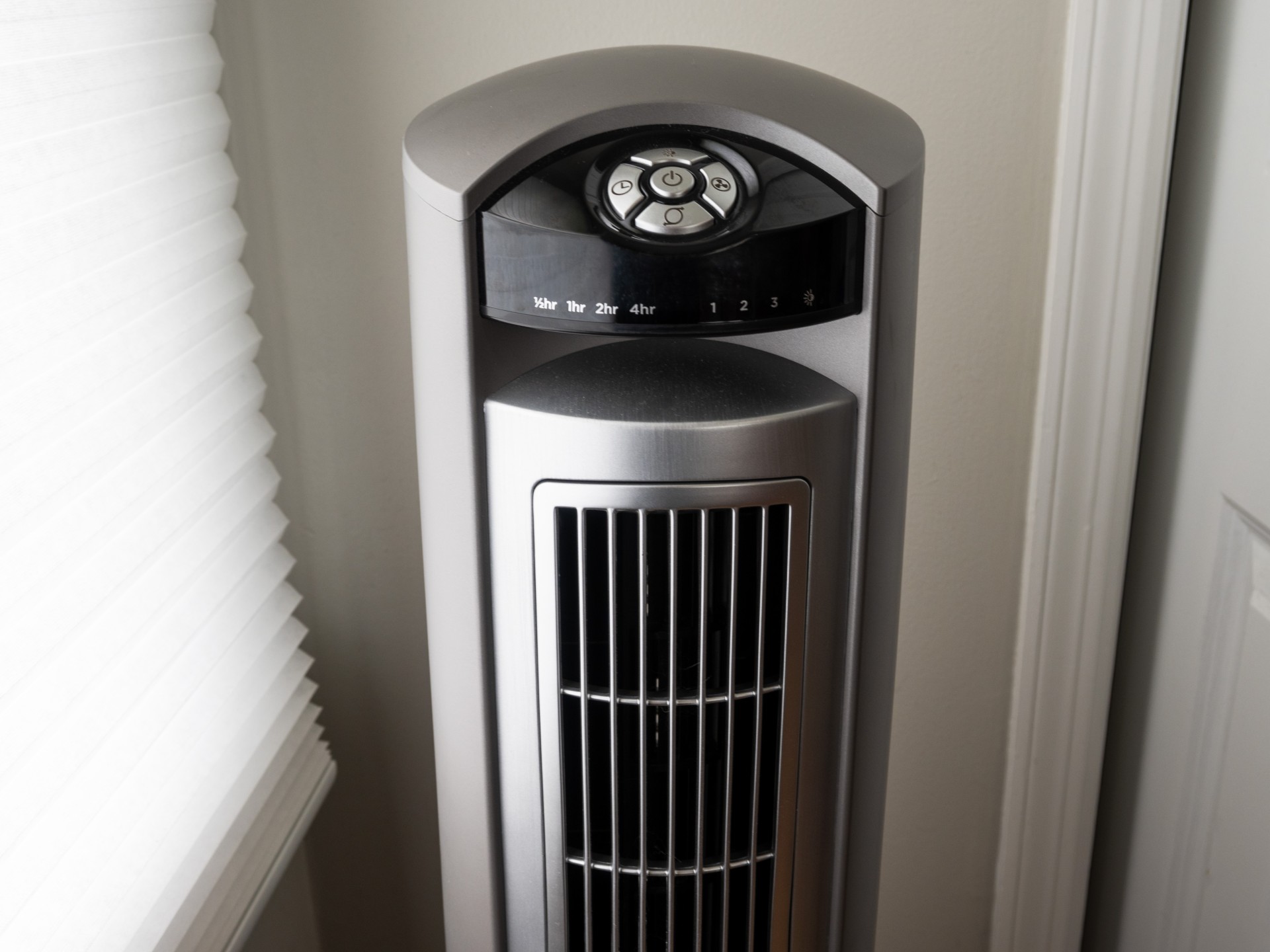
| Ease of Use | Air Circulation | Noise | Portability | Value | |
| Lasko T42951 42-Inch Wind Curve Oscillating Tower Fan | 5/5 | 5/5 | 4.5/5 | 5/5 | 5/5 |
| Honeywell QuietSet Mini Tower Table Fan | 5/5 | 4/5 | 5/5 | 5/5 | 5/5 |
| Vornado 154 32-Inch Tower Circulator | 5/5 | 5/5 | 3/5 | 5/5 | 4/5 |
| Lasko FH500 1500W All-Season Tower Fan & Space Heater | 5/5 | 5/5 | 4.5/5 | 5/5 | 4.6/5 |
| Lasko T42950 Wind Curve Tower Fan With Ionizer | 5/5 | 5/5 | 3/5 | 5/5 | 4/5 |
How We Tested the Best Tower Fans
We tested various tower fans using a detailed rubric to create a guide to the best options. Each fan was evaluated based on five key components: ease of use, air circulation, noise levels, portability, and value. We assessed factors such as user interface, cooling power at different distances, sound levels at various speeds, ease of movement, and overall price.
We assigned scores out of five for each category and then calculated the total scores to rank the fans. This thorough approach ensures that our recommendations are dependable and tailored to your needs.
| Testing Stats | |
| Products tested | 11 |
| Time spent testing | 2 weeks |
| Tests performed | 5 |
| Price range | $40 to $100 |
What to Consider When Choosing a Tower Fan

When shopping for the best tower fan for your home or office, there are a few things to consider, including type, size, capacity, noise level, and additional features.
Type
Tower fans are available in different types that vary in functionality including floor standing, desktop/portable, bladeless, and smart. Here are some key features included in these respective types:
- Floor standing: Most tower fans that are floor standing take up less space than pedestal or traditional fans because they have a small footprint with a tall and narrow design. Floor-standing fans also tend to blend well with the decor in the room, with a sleek style compared to a pedestal fan. In addition, floor-standing fans can cool a whole room.
- Desktop/portable: A smaller version of a floor-standing fan, desktop/portable tower fans work on side tables, desks, countertops, and tables. You can use them more as a personal fan while working, sleeping, sitting, and watching TV.
- Bladeless: The blades in a “bladeless” fan are hidden inside the ring that forms around the center. A bladeless design provides more safety because small children can’t hurt their fingers and animals can’t injure their tails in spinning blades. They are also much easier to clean because you don’t need to access the blades to dust them. These fans are generally much quieter than standard tower fans. There is one negative to note with all these positives: Bladeless fans tend to cost much more than traditional tower fans.
- Smart: Some fans come with Bluetooth technology and the ability to install an app on iOS or Android so users can control the fan from a phone or a tablet. Shoppers can find smart floor-standing, desktop, and bladeless fans.
Size
Most tower fans are designed to be tall and slender to circulate air through a room without taking up significant space. Most floor-standing models are about 50 inches high with heads between approximately 18 and 30 inches in diameter. While a pedestal fan with a larger head occupies more space, it is also capable of moving more cold air.
Pedestal fans must accommodate the dimensions of the space they’ll be cooling, so it’s essential to consider room size so as not to end up with a model that’s too small. An 18-inch fan should function well for the average bedroom or a small living area, while a larger 30-inch fan is suitable for ventilating large rooms like a garage or a living room.
Functions
While the primary function of a tower fan is to cool a room, shoppers will come across other functions and additional features while shopping for one.
- Oscillating tower fan: Most tower fans oscillate, or rotate from side to side, in order to direct cool air over a wider area or an entire room. Consumers will typically find tower fans with an oscillating arc of 90 or 95 degrees. A handful of tower fans on the market can oscillate a full 360 degrees, but unless you plan to place the fan in the center of a room, full-circle rotation is probably unnecessary. Some models also come with the ability to select the width of the oscillating arc.
- Heating: Some tower fans also come with heating for the colder months. It allows you to warm up a room without necessarily turning up the heat in the entire house.
- Ionizing: Built-in ionizers will release negative ions that bond with positive ions, such as smoke and other particles from the air. As they bond, they will fall to the ground, and the air will become fresher.
- Air purifying: Some tower fans come with a high-efficiency particulate air (HEPA) filter that will ideally remove up to 99.97 percent of dust, pollen, mold, bacteria, and other airborne 0.3-micron particles from the air.
CFM and Speed Settings
A fan’s cooling power is determined by measuring how much air the fan can move within 1 minute, which is expressed in CFM. Manufacturers use the CFM measurement as a way to empirically demonstrate the amount of airflow the fan can produce, which is especially important for cooling large rooms, garages, and industrial or commercial spaces.
The CFM measurement is typically provided as the maximum amount of airflow, but many fans have additional speed settings that can be used for reduced airflow and quiet operation. It’s common to have a low, medium, and high setting, which may also be represented as 1, 2, or 3 on a fan. The low setting is great for simply moving the air in the room without feeling a direct breeze, while medium and high settings will increase the speed and airflow so the breeze can reach people across a room.
To determine the appropriate CFM airflow for your tower fan, consider room size:
- Under 200 square feet: 3,000 CFM or less
- 200 to 300 square feet: 3,000 CFM to 4,000 CFM
- 300 to 450 square feet: 4,000 to 6,000 CFM
- Over 450 square feet: 6,000 to 1,000 CFM
Fan Modes
Most tower fans come equipped with modes for easy operation, such as a thermostat that automatically turns the unit on and off based on room temperature. Some models also have timers that turn them off after a preset number of hours, preventing the floor fan from accidentally being left on in an unoccupied room.
Many of the best tower fans for bedroom spaces have a night mode, which runs the fan at a quiet speed for 6 hours before shutting off, and a turbo mode, which runs at high speed for maximum airflow and cooling power. The user can set these modes on a control console on the fan or, if included, via a remote from across the room.
Noise Level
Since tower fans have smaller blades, they’re typically quieter than other types of fans. Most produce a low “humming” noise as opposed to the louder “whooshing” noise of fans with larger blades. The sound usually isn’t loud enough to impede conversation or hinder sleep. On lower settings, tower fans will typically emit even less sound, leading some manufacturers to use terms like “whisper-quiet” and “calm.”
Some tower fans have a quieter nighttime setting, and bladeless fans tend to produce the least amount of noise. If quiet operation is a priority, stick with a tower fan that has a lower decibel rating. For comparison, a normal conversation is about 55 decibels, whispering is about 30 decibels, ambient office noises are around 70 decibels, and a noisy restaurant is approximately 80 decibels.
FAQs
Now that you know more about tower fans, you might still have questions about how they work and how they are used. The following are answers to some of the most frequently asked questions about tower fans to help you get the most out of your purchase. he most frequently asked questions about tower fans to help you get the most out of your purchase.
They circulate the air in a room and increase comfort. These fans are particularly effective in summer months when heat is tough to battle, which is why they come with powerful airflow settings to keep a home cool. Plus, many come with oscillation for distributing air evenly throughout a home.
Although tower fans are considered powerful among their regular counterparts, they are not the strongest fan variety on the market. Pedestal fans have larger blades and will provide more air circulation than a tower fan.
An oscillating fan rotates from side to side in order to direct airflow over a wider area. Many of the tower fans available today can be programmed to run an oscillating fan cycle to keep air circulating around a room continuously. This fan is particularly helpful for those who like to sleep with a fan on in their bedroom.
One of the quietest tower fans on the market today is the Dreo Cruiser Pro T1 Tower Fan. This tower fan is perfect for offices and bedrooms since it causes little to no noise pollution and distributes air evenly throughout a space.
To clean a fan, turn off and unplug the fan. Then use compressed air or a vacuum brush attachment to clean the vents.
Meet the Testers
Glenda Taylor is a product tester and writer specializing in the construction, remodeling, and real estate industries. She tests a wide range of power tools as well as other home improvement, household, and lawn-and-garden products.
Debbie Wolfe is a photographer, author, and freelance writer in various niches. She has contributed hundreds of home, garden, and crafting articles and DIY tutorials for leading media outlets and retailers, Her testing approach is straightforward and budget-minded.
Additional research provided by Andréana Lefton and Tiffany Lewis.



